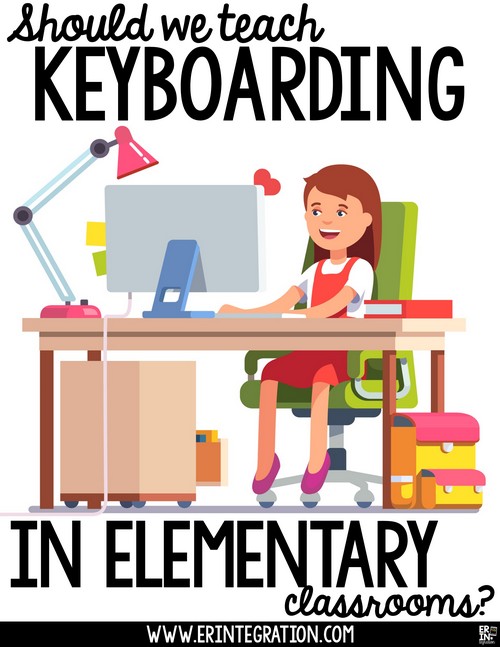I get a lot of questions about keyboarding and typing in elementary, mainly what programs I recommend and if I even do it at all. Many teachers are required to provide some sort of keyboarding practice – especially now that most standardized tests are online, but before jumping in, I think teachers need to be strategic about how they approach typing in elementary.

I did some research on PubMed and I wanted to share where I come in personally and why. Disclaimer: This isn’t a deep dive, research paper, or peer-reviewed journal, but a mix of some research and my ideas.
Research About Keyboarding
- A study in 2012 found that vertical and horizontal spaces between keys of 16-19mm provide the most speed and accuracy for typing. The average keyboard has spacing of 19mm. This study was done with ADULT hands with a mean middle finger of 8.7cm.
- A separate study of children’s finger lengths found the average middle finger length of 3-10 year olds was 2.8cm.
- In addition, limited research conducted on WPM for students gives no recommendation for before 3rd grade.
In short (just like their little fingers lol) keyboards are not designed for children’s hands and thus typing WPM goals for K-3 and leaderboards need to be re-evaluated.
My Recommendation for Teaching Keyboarding Skills
Based on the above, I recommend that you mainly focus on technique, location of keys, skills (spacing, using the Shift key, Enter, location of the Delete key, location of the dang @ for usernames, etc) until 3rd or even 4th grade. It’s not that keyboarding isn’t important, it’s more that your time is precious, and the research doesn’t support kids becoming fluent in typing prior to 3rd grade to the point that it requires specific, direct instruction on home row keys. While you may have exceptions, you will end up wasting time that could be better spent doing other activities.
Plus, most kids are going to be using Smartphones, touch screen tablets and voice to text or speech recognition. While we all have anecdotal experiences that make us feel keyboarding is an important skill – hello, my speedy wpm allows me to type these blog posts quickly – we can’t say for sure that home row typing is here to stay as other technologies and devices streamline other methods.
As far as keyboarding goes, we have to be careful to separate our personal experiences from what is actually good and useful to our current students.
What if 200 years ago, teachers spent time focused on telegraph skills over other subjects and objectives? What if teachers in the 90s spend time teaching the ins and outs of fax machines to their elementary students instead of allowing them to explore and create on Kidpix. Obviously, these aren’t perfect metaphors, but we do need to be mindful when teaching technology so that we don’t focus so much on mastering the tech and not on the big picture: the transferable skills that can be used for years to come.
Tips for Developing Keyboarding Awareness in Elementary
If your time with devices is limited, forgo traditional home row typing instruction for integrated activities. Integrate keyboarding skills into the existing curriculum when appropriate using the devices you have available to you. Here is a short list of some easy ways you can have students practice typing while also practicing other skills.
- Have students type stories on any word processor.
- Create a class blog (use Edublogs, Kidblog, or Seesaw) and have students post and comment.
- Have students read articles on DogoNews or Wonderopolis and comment.
- Add captions, labels, titles, and text to images on Google Drawing and Pic Collage.
- Use digital interactive notebooks on Google Slides.
- Have students make Booksnaps during reading.
- Create ASCII text art.
- Practice typing usernames and passwords.
If you do have time for typing practice, aim for programs with individualized self-paced lessons that allow practice for no more than 5-10 minutes. Some programs I have heard good things about from the educators in our Teach with Tech Facebook Group {Click to join!}:
- Typing Club
- Keyboarding Without Tears
- EduTyping
- Nitro Type
- Typetastic
- Dance Mat Typing (BBC)
- Typing.com
- Keyboarding Online
While some hardline keyboarding gurus (is this a thing?) may feel that bad habits such as hunt and peck can be too hard to break and thus kids should be taught proper form from the get-go, I’ve found plenty of evidence otherwise. Kids brains are malleable and when their fingers are the proper size for keyboarding, they will be able to develop the motor skill memory and pathways needed for proper technique.
A Case for Keyboarding
Are you a middle school or secondary teacher? Then yes, teach keyboarding. Students will pick it up faster if elementary teachers did their due diligence in having students develop age-appropriate experiences with typing. Be sure to stress technique then accuracy over speed – speed will come with time.
However, just as I stated above, if you are limited with access to devices, be thoughtful and strategic with how you approach keyboarding programs and practice. Most students can learn in a semester with focused practice. There is a lot of research into keyboarding techniques so be sure to pick a program that based on best practice. Education World has a great article about keyboarding and programming.
I’m sure you will find other teachers feel differently about keyboarding, but as most things in elementary – the decision will ultimately be made based on time – the time you have available and how it makes the most sense to use it. In my opinion, there isn’t enough evidence to devote time to keyboarding over other learning. I would prefer primary students were creating, collaborating, and critical thinking with devices then being drilled in keyboarding. What do you think?
